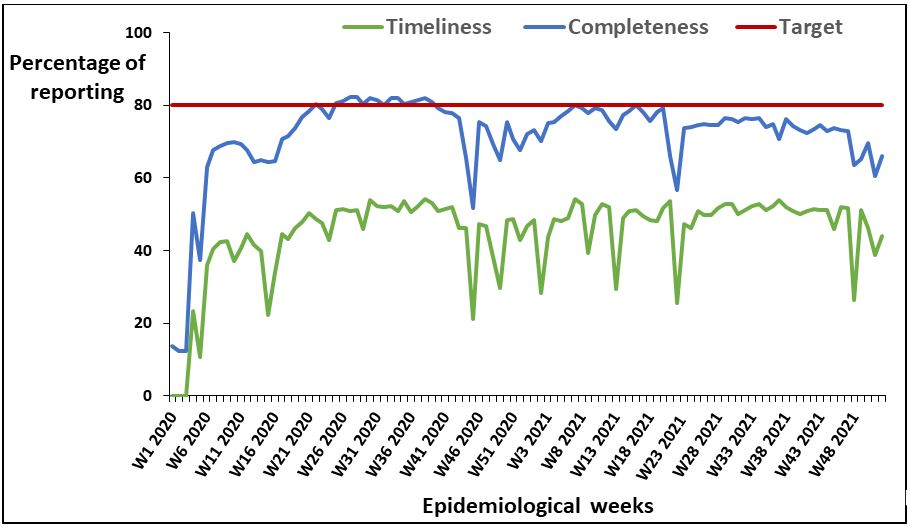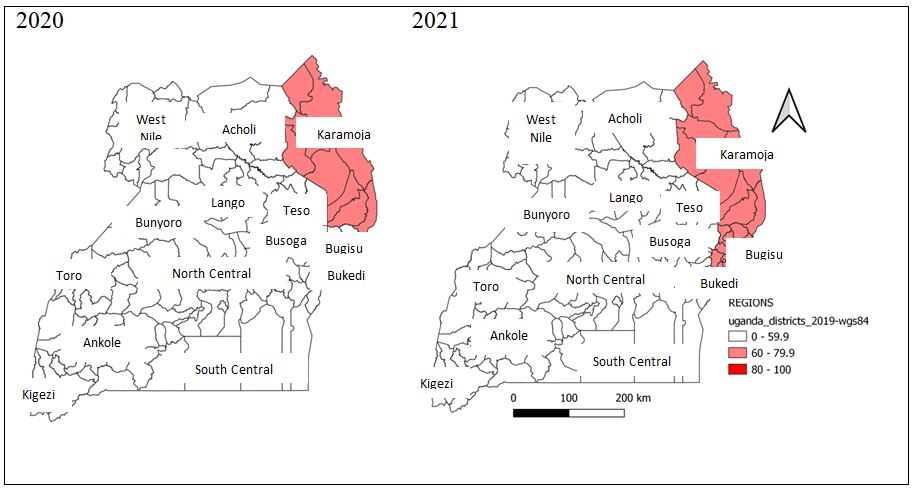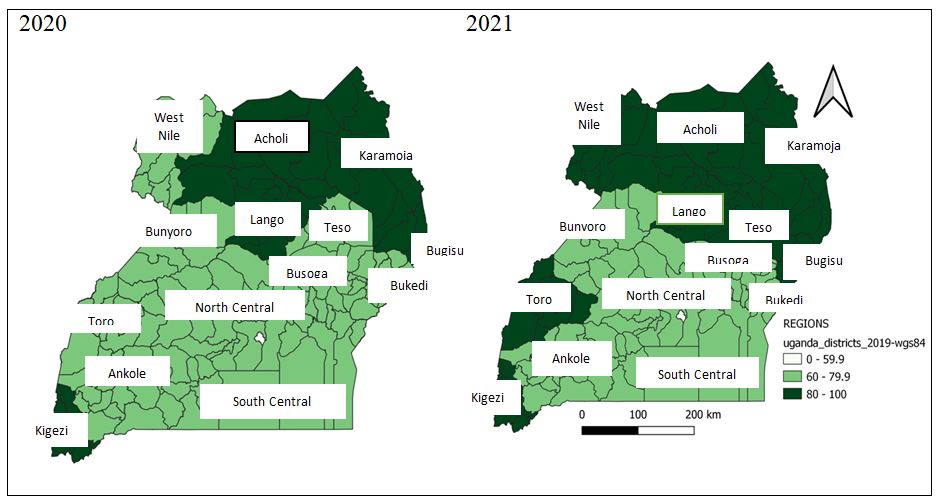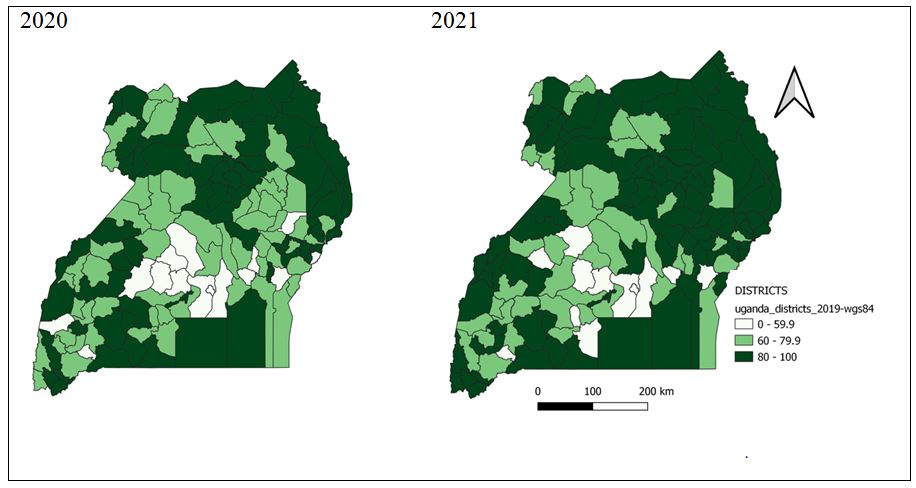
Weekly surveillance data reporting on epidemic prone diseases, Uganda, 2020–2021
Authors: Hildah Tendo Nansikombi1*, Benon Kwesiga1, Emma Sam Arinaitwe2, Leocadia Kwagonza2, Julie R. Harris3___ Institutional affiliations: 1Uganda Public Health Fellowship Program, Kampala, Uganda, 2Ministry of Health, Uganda 3US Centers for Disease Control and Prevention, Kampala, Uganda___ *Corresponding author: Email: hnansikombi@musph.ac.ug, Tel: +256777570470
Summary
Background: Disease surveillance provides vital data for disease prevention and control programs. Incomplete and untimely data are common challenges in planning, monitoring, and evaluation of health sector performance, and health service delivery in many African settings. We described the completeness and timeliness of weekly surveillance data reporting on epidemic prone diseases, Uganda, 2020-2021. Methods: We abstracted data on completeness and timeliness of weekly reporting on epidemic prone diseases from 136 districts of Uganda from the District Health Information System version2 (DHIS2) platform. Timeliness is the proportion of all expected weekly reports from 136 districts of Uganda that were submitted to DHIS2 by 12:00pm of the Monday of the following week. Completeness is the proportion of all expected weekly reports from 136 districts of Uganda that were completely filled and submitted to DHIS2 by 12:00pm of the Wednesday of the following week. We determined the proportions and trends of completeness and timeliness of reporting at national level by year, health regions, and district. Results: National average of reporting timeliness and completeness was 49% and 75% in 2021 while in 2020, it was 44% and 70% respectively. Both weekly completeness and timeliness of reporting increased in 2021 by 5% when compared to 2020. Eight of the 15 health regions achieved the target for completeness at 80%; Lango Region attained the highest (93%) in 2020, and Karamoja Region attained 96% in 2021. None of the regions achieved the target for timeliness at 80% in both 2020 and 2021. Kampala District attained the lowest in completeness of reporting:38% and 32% in 2020 and 2021 respectively, registering a 6% decrease. Kampala District still attained the lowest in timeliness of reporting (19%) in the both 2020 and 2021. Conclusion: Weekly reporting on epidemic prone diseases became more complete over time, but timeliness of reporting is still poor. Further investigations to identify particular bottlenecks to reporting completeness and timeliness of surveillance data are needed to address the variations at both district and regional levels.
Background
Uganda is a low-income country that continues to experience disease outbreaks caused by emerging and re-emerging diseases such as cholera, typhoid, COVID-19, and viral haemorrhagic fevers [1, 2]. Infectious disease outbreaks if not detected and reported early can rapidly spread and result in high morbidity and mortality [3]. To curb the effects of disease outbreaks, effective public health surveillance systems are needed to provide timely and accurate information leading to early detection of potential outbreaks and containing them in the local areas [2, 4].
The key strategy for implementing public health surveillance in African countries is the Integrated Disease Surveillance and Response (IDSR) strategy which was launched by WHO Afro in 1998 [5, 6]. One of the main goals of IDSR implementation is to monitor disease and public health event trends in order to ensure that any unusual disease patterns such as outbreaks are detected quickly, investigated, and responded to within the shortest time [6, 7].
The IDSR system in Uganda refers to reportable priority diseases as per the third edition of IDSR Technical Guidelines launched in 2021. The diseases are categorized as follows: diseases targeted for elimination, epidemic prone diseases, diseases of public health importance, and public health events of international concern under IHR 2005 [8]. These priority diseases have varying reporting timelines and requirements. Surveillance data on these diseases is reported as immediate, weekly, monthly or quarterly reports. Reports on epidemic prone diseases must be sent weekly [2].
Diseases, conditions or events that must be reported weekly are 20 as follows: Acute Flaccid Paralysis (AFP), Acute haemorrhagic fever syndrome (Ebola, Marburg, Lassa Fever, Crimean-Congo), Acute Jaundice, Adverse events following immunization (AEFI), Anthrax, Cholera, Dengue fever, Diarrhoea with blood (Shigella), Guinea Worm Disease (Dracunculiasis), Malaria, Malnutrition in under 5 years, Measles, Meningococcal Meningitis, Maternal death, Neonatal death, Neonatal tetanus, Plague, Rift Valley Fever, Severe Acute Respiratory Illness (SARI) clusters, Rabies, Typhoid, Yellow fever, and laboratory confirmed multidrug and extremely drug resistant Tuberculosis [6, 8].
In Uganda, disease surveillance information is reported in a hierarchical order from the communities through the 136 districts to the national health system. At each level of the health system, as data are transferred from one level to another, problems of completeness, timeliness, and data quality may be incurred leading to unreliable information for planning, monitoring, and health service delivery [9]. To combat such challenges, surveillance systems need to be periodically assessed on key indicators such as completeness and timeliness of reporting to ensure that the objectives of surveillance are being met. For this reason, IDSR performance is often evaluated on completeness of reporting (proportion of districts submitting completely filled reports and timeliness of reporting (proportion of districts submitting reports on time) through the District Health Information System version 2 (DHIS2) [5, 10]. The DHIS2 automatically determines the number of reports submitted against the number expected to estimate completeness (by midday every Wednesday). It also indicates the number of reports which are submitted on time (by midday every Monday) [8].
After several years of IDSR implementation in Uganda, assessment of its performance was conducted in 2016 and revealed improvements in both timeliness (40 to 68%) and completeness (56 to 78%) of reporting at national level since 2012 when the second edition of IDSR was launched [1]. This assessment was conducted in only a few selected districts using district data. Furthermore, given the challenges posed by the COVID-19 pandemic to public health surveillance and response, it is important to document the performance of key surveillance indicators amidst the COVID-19 pandemic. However, DHIS2 data on completeness and timeliness of reporting was available starting from 2020. We described the timeliness and completeness of weekly surveillance data reporting on epidemic prone diseases, Uganda, 2020 to 2021.
Methods
Study setting
Uganda is made up of fifteen health administrative regions which are further divided into 136 districts and health facilities. Health service delivery is organised in tiers; from Health Centre (HC) I, HC II, HC III, HC IV, general hospital, regional referral hospital, and national referral hospital. Operationally, HC I are Village Health Teams (VHTs) that provide referral services to the higher levels.
Data source and disease surveillance reporting procedures
Surveillance data on completeness and timeliness of reporting on epidemic prone diseases is stored on the DHIS2. The DHIS2 is an open-source web-based platform maintained at the national level by the Ministry of Health (MoH). The software is used for reporting, analysing, and disseminating health data as part of the Health Management Information System (HMIS). Disease surveillance reporting in Uganda follows a hierarchical order from community level to the national level of the health system through the DHIS2. At the community level, surveillance activities are conducted by community volunteers (village health teams) who are trained using simple case definitions and report their observations to the periphery health facilities. Then at the health facility level, the data are differentiated including information from out-patient, in-patient, consulting room and laboratory registers into daily summary sheets and IDSR reporting forms. The data are then sent to the district health office (DHO) as immediate, weekly, monthly or quarterly reports. The reports are received at the DHO by the biostatisticians who enter the data into the electronic DHIS2, which has the capability to automatically aggregate the information, reported from the periphery health facilities into district level data. The aggregated data sent from the district to the regional level using the DHIS2 are merged into regional and national level datasets. The periphery, district, and regional levels have specified times for reports submission. The DHIS2 system automatically determines the number of reports submitted against the number expected to estimate timeliness (by midday every Monday). It also indicates the number of complete reports (by midday every Wednesday) [8].
Study variables, data abstraction, and analysis
We analysed data on completeness and timeliness of weekly reporting of epidemic prone diseases from all the 136 districts of Uganda reporting through the DHIS2. Timeliness is the proportion of all expected weekly reports from all 136 districts of Uganda that were submitted to DHIS2 by 12:00pm of the Monday of the following week. Completeness is the proportion of all expected weekly reports from 136 districts of Uganda that were completely filled and submitted to DHIS2 by 12:00pm of the Wednesday of the following week. We determined the overall proportions and trends of completeness and timeliness of reporting at national level by year, health regions, and district.
Ethical considerations
We used routine surveillance data reported by districts to the MoH for this analysis. The data is aggregated with no identifying information. The US Centres for Disease Control and Prevention (CDC) provided non-research determination for this analysis. We also sought and obtained permission from MoH to use the data.
Results
National completeness and timeliness of weekly surveillance data reporting on epidemic prone diseases, Uganda, 2020 –2021
Trend of timeliness of weekly surveillance data reporting on epidemic prone diseases, Uganda, 2020 –2021
Data on timeliness of reporting was recorded beginning epidemiological week four of 2020 with 23% timeliness of reporting. The national timeliness of reporting was below the 80% target throughout 2020 and 2021 (Figure 1). The national timeliness of reporting was 49% in 2021 compared to 44% in 2020, indicating a 5% increase over the two-year period.
Trend of completeness of weekly surveillance data reporting on epidemic prone diseases, Uganda, 2020 –2021
The national completeness of reporting was 14% in epidemiological week one of 2020, increased over time and reached the 80% target at epidemiological week 22 of 2020 though dropped at week 43 and remained below the target until the end of 2021 (Figure 1). The national completeness of reporting was 75% in 2021 compared to 70% in 2020, indicating a 5% increase over the two-year period.

Completeness and timeliness of weekly surveillance data reporting on epidemic prone diseases by health region, Uganda, 2020 –2021
Timeliness of weekly surveillance data reporting on epidemic prone diseases by health region, Uganda, 2020 –2021
None of the 15 health regions achieved the national target for timeliness of reporting at 80%. However, there was a notable increase in timeliness of reporting across all health regions except Kampala Region which also attained the lowest in timeliness of reporting (19%) in both 2020 and 2021 (Figure 2).

Completeness of weekly surveillance data reporting on epidemic prone diseases by health region, Uganda, 2020 –2021
Of the 15 health regions, eight achieved the target for completeness of reporting at 80%; Karamoja and Lango Regions attained the highest 96% and 93% in 2021 and 2020 respectively. Unlike other regions registering improvement in completeness of reporting from 2020 to 2021, Kampala Region attained the lowest and registered a 6% decrease: 38% and 32% in 2020 and 2021 respectively (Figure 3).

Timeliness of reporting weekly surveillance data reporting on epidemic prone diseases by district, Uganda, 2020 –2021
Timeliness of reporting was poor throughout 2020 and 2021, below 60% in many of the districts. Only Kibuku District attained the 80% target for timeliness of reporting in 2020 (81%). In 2021, nine districts improved and attained target for reporting timeliness: Buyende (88%), Isingiro (84%), Kibuku (83%), Rakai (82%), Nwoya (98), Lira (80%), Kalangala (86%), Kyotera (86%), and Kaabong (82%) (Figure 4).

Completeness of weekly surveillance data reporting on epidemic prone diseases by health district, Uganda, 2020 –2021
Majority of the districts achieved the 80% target of completeness of reporting in 2020 and improvements continued to be seen in 2021. All districts in Karamoja Region attained and maintained the 80% target of completeness throughout 2020 and 2021. Districts of Kampala, Busoga Region (Bugiri, Jinja), and South-central Region (Bukomansimbi, Masaka, Kassanda, Wakiso), and Rwampara continued to perform poorly with less than 60% completeness of reporting throughout 2020 and 2021 (Figure 5).

Discussion
This study addresses an important aspect of public health surveillance systems in Sub-Saharan Africa (SSA). Our findings indicate improvements in surveillance data reporting both at regional and national levels, which supports similar findings from SSA of progress in reporting completeness and timeliness associated with either IDSR system or DHIS2 implementation [2, 11, 12]. In spite of the observed improvements, the overall reporting completeness and timeliness remains insufficient below the 80% target, and varies greatly by health regions and district.
Although Kiberu et al. argued that challenges of data reporting seem to have been resolved through the use of DHIS instead of paper-based forms in Uganda, this may have worked for a few districts. The increases in both completeness and timeliness of reporting are likely due to the internet-based reporting and continuous reminders of reports submission through personal mobile phones as it has been reported from other countries [13, 14]. In addition, the ongoing COVID-19 pandemic might have increased biostatisticians’ and surveillance focal persons’ alertness and understanding of the need for surveillance data reporting, thus the improvement in reporting completeness and timeliness as reported by similar studies [15, 16].
However, our findings don’t fully support this since data before the pandemic are not available for us to understand the impact of the pandemic on surveillance data reporting. On the other hand, the poor reporting rates in some districts might have been influenced by poor motivation, network and internet challenges, which have potential for error introduction thus affecting data accuracy [17].
The findings further revealed low and varied levels in the reporting timeliness at districts and regional levels. This is in line with previous studies which reported that low timeliness is still common at all levels of health services [12, 18]. The possibility of missing outbreaks and delays in public health response such as contact tracing due to untimely and incomplete reporting appears to be a real challenge in the Uganda health system. Continued training of disease surveillance and health information officers in addition to routine validation of data reports by biostatisticians can help improve completeness, timeliness and data quality of reporting. In the long term, plans should be initiated to scale up data entering into DHIS2 by the periphery health system such as health centres, clinics, to address issues of completeness and timeliness.
Our study should be interpreted based on the following limitations. Firstly, the findings were based on a short duration since data were only available in DHIS2 from 2020; the data only covered the COVID-19 pandemic period. We couldn’t therefore describe reporting before and during the pandemic to establish its effect on surveillance data reporting. Secondly, common challenges with internet data transmission in all parts of Uganda might have introduced some data errors resulting in bias in our findings.
Conclusion
Timeliness and completeness of weekly epidemic prone disease surveillance reporting through DHIS2 improved over time. However, despite these improvements, timeliness of reporting still remains poor below target in most of the districts and all health regions. Continuous support supervision, mentorship and additional system/infrastructure enhancements, including internet connectivity, may be required to further enhance surveillance data reporting. Further investigations to identify particular bottlenecks to reporting completeness and timeliness of surveillance data are needed to address the variations at district and regional levels.
Acknowledgements
We appreciate the biostatisticians and surveillance officers that ensure reporting of surveillance data from their respective districts, as well as the team managing the DHIS2 platform; your hard work enabled the availability of the data we used for this analysis. We acknowledge the Uganda Public Health Fellowship Program for the technical guidance towards making the analysis a success.
References
- Masiira, B., et al., Evaluation of integrated disease surveillance and response (IDSR) core and support functions after the revitalisation of IDSR in Uganda from 2012 to 2016. BMC Public Health, 2019. 19(1): p. 46.
- Mremi, I.R., et al., Twenty years of integrated disease surveillance and response in Sub-Saharan Africa: challenges and opportunities for effective management of infectious disease epidemics. One Health Outlook, 2021. 3(1): p. 22.
- Mboussou, F., et al., Infectious disease outbreaks in the African region: overview of events reported to the World Health Organization in 2018. Epidemiol Infect, 2019. 147: p. e299.
- Groseclose, S.L. and D.L. Buckeridge, Public Health Surveillance Systems: Recent Advances in Their Use and Evaluation. Annual Review of Public Health, 2017. 38(1): p. 57-79.
- Fall, I.S., et al., Integrated Disease Surveillance and Response (IDSR) strategy: current status, challenges and perspectives for the future in Africa. BMJ Global Health, 2019. 4(4): p. e001427.
- Kasolo, F., et al., IDSR as a platform for implementing IHR in African countries. Biosecur Bioterror, 2013. 11(3): p. 163-9.
- Lukwago, L., et al., The implementation of Integrated Disease Surveillance and Response in Uganda: a review of progress and challenges between 2001 and 2007. Health Policy and Planning, 2012. 28(1): p. 30-40.
- MoH, National Technical Guidelines for Integrated Disease Surveillance and Response – Third Edition. 2021.
- Mutale, W., et al., Improving health information systems for decision making across five sub-Saharan African countries: Implementation strategies from the African Health Initiative. BMC Health Services Research, 2013. 13(2): p. S9.
- Njeru, I., et al., Use of technology for public health surveillance reporting: opportunities, challenges and lessons learnt from Kenya. BMC Public Health, 2020. 20(1): p. 1101.
- Dixon, B.E., et al., Completeness and timeliness of notifiable disease reporting: a comparison of laboratory and provider reports submitted to a large county health department. BMC Medical Informatics and Decision Making, 2017. 17(1): p. 87.
- Adokiya, M.N., et al., Evaluation of the reporting completeness and timeliness of the integrated disease surveillance and response system in northern Ghana. Ghana Med J, 2016. 50(1): p. 3-8.
- El-Khatib, Z., et al., SMS-based smartphone application for disease surveillance has doubled completeness and timeliness in a limited-resource setting – evaluation of a 15-week pilot program in Central African Republic (CAR). Conflict and Health, 2018. 12(1): p. 42.
- Ng’etich, A.K.S., et al., A systematic review on improving implementation of the revitalised integrated disease surveillance and response system in the African region: A health workers’ perspective. PLOS ONE, 2021. 16(3): p. e0248998.
- Hardhantyo, M., et al., Quality of National Disease Surveillance Reporting before and during COVID-19: A Mixed-Method Study in Indonesia. Int J Environ Res Public Health, 2022. 19(5).
- Kostkova, P., et al., Data and Digital Solutions to Support Surveillance Strategies in the Context of the COVID-19 Pandemic. Frontiers in Digital Health, 2021. 3.
- Kiberu, V.M., M. Mars, and R.E. Scott, Barriers and opportunities to implementation of sustainable e-Health programmes in Uganda: A literature review. Afr J Prim Health Care Fam Med, 2017. 9(1): p. e1-e10.
- Overhage, J.M., S. Grannis, and C.J. McDonald, A Comparison of the Completeness and Timeliness of Automated Electronic Laboratory Reporting and Spontaneous Reporting of Notifiable Conditions. American Journal of Public Health, 2008. 98(2): p. 344-350.
Reference this page as below
Hildah Tendo Nansikombi1*, Benon Kwesiga1, Emma Sam Arinaitwe2, Leocadia Kwagonza2, Julie R. Harris3 , Weekly surveillance data reporting on epidemic prone diseases, Uganda, 2020–2021. Kampala, Uganda National Institute of Public Health. 2022 March 30th. Available from: https://uniph.go.ug/weekly-surveillance-data-reporting-on-epidemic-prone-diseases-uganda-2020-2021
